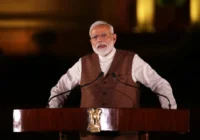Reporting in The New York Times over a man tied to a military jeep in Kashmir fails to establish the context.
In 1953, The New York Times supported the CIA-led coup that ousted Prime Minister Mohammed Mossadegh in Iran. More recently, it acted as a cheerleader when George W. Bush decided to invade Iraq. That the war in search of weapons of mass destruction still continues in a different and more vicious form should be food for thought for publications like The NYT. Ironically, while the search for WMDs ended in a whimper in Iraq, it did create physical weapons of mass destruction in the form of Abu Musab al-Zarqawi and Abu Bakr al-Baghdadi.
The New York Times needs to be reminded of the fact that it was perhaps the encouragement provided by its war drums that the US government felt unfettered of democratic niceties while establishing hell holes like Abu Ghraib and Guantanamo. To, therefore, subtly allude to Indian atrocities in tying a Kashmiri man to a jeep and parading him through villages reeks of hypocrisy.
It is an acceptable fact that in a conflict situation, which Kashmir undoubtedly faces today, it is prudent to search for the truth in gray. To fall hook, line and sinker for the propaganda machinery created by Pakistan’s Inter-Services Intelligence (ISI) shows that hubris has overruled common sense in such Western media circles. The NYT’s attempt to paint the Indian army as the villain of not only this incident, but also the problem in Kashmir has perhaps unknowingly made it side with Islamist terrorists, aided and abetted by ISI, who have brought misery to the pristine land of Kashmir.
KASHMIR: THEN AND NOW
The genesis of the Kashmir problem lies in the colonial chicanery that India was subjected to at the time of its partition in 1947. Undeterred by the legalities of accession of Kashmir into India, the Pakistani army’s invasion under the garb of irregular tribals set off a hybrid conflict that has refused to abate. The dispute is nowhere near a resolution despite India and Pakistan fighting three wars since. In the interim, the Kashmir Valley has been witness to the most brutal ethnic cleansing in modern history since the Holocaust of World War II. The forced migration of 350,000 Kashmiri Pandits under threat of murder, rape and pillage, accompanied by the death of thousands of their brethren, remains a scar on Indian democracy.
The conflict intensified in the late 1970s following the ascent of Pakistan’s General Muhammad Zia-ul-Haq, who was quick to realize the futility of taking on the Indian army in a conventional war. It was Zia who instituted the policy of “bleeding India through a thousand cuts.” The conflict has escalated gradually ever since.
The present cycle of violence in Kashmir has taken a vicious turn ever since the killing of Burhan Wani, commander of the terrorist organization Hizb-ul-Mujahideen, by security forces in July 2016. The introduction of stone throwers into the scene has ensured that the Kashmir Valley has not seen peace since. While any nation would have gone for head hunting when confronted with a primeval mode of warfare, the Supreme Court in India has asked the government to search for alternatives to the pellet gun that security forces have used to disperse violent mobs.
It is in this context that the incident in Budgam occurred, where Farooq Ahmad Dar was tied to a jeep by the Indian army and used as a human shield against stone throwers. As the propagandists, including The New York Times, have projected Dar as an innocent bystander who fell prey to the depravations of the military, it would be safe to presume that rather than displaying presence of mind that saved bloodshed, the leader of the army’s Quick Reaction Team — which arrived there on an SOS mission to rescue outnumbered election officials and security men — should have opened fire to save them from certain lynching by the mob that had surrounded the polling station. The officer should be commended for adopting a comparatively non-violent method to combat violence.
Coming from a publication that defends the right of its military to operate misfiring drones, The NYT’s argument sounds specious. It would be interesting to hear the US daily’s take on former Afghan President Hamid Karzai castigating the US for treating Afghanistan “as [a] testing ground for new and dangerous weapons,” following the use of the biggest non-nuclear bomb in the world on Islamic State (IS) militants.
It is high time the West understood that Kashmir is not an indigenous freedom struggle as portrayed by the Inter-Services Intelligence and certain media outlets. Ever since the street violence broke out in July 2016 after the killing of Wani, the flags of the Islamic State are omnipresent in such protests. The statement of Zakir Musa, successor of Burhan Wani — “Whenever we are fighting with gun or throwing rocks, this should not be for nationalism but for Islam” — epitomizes the fact that what Kashmir confronts today is an extension of the battle that IS wages in Syria and Iraq and has offloaded to the West.
The Indian army has displayed remarkable restraint in the face of unbridled provocation from terrorists and provocateurs. Officers have lost their lives after being exposed to terrorist fire by the sudden appearance of flash stone-throwing mobs at encounter sites. It has maintained the restraint despite the warning by Chief of Army Staff General Bipin Rawat that in “the local population [are] people who have picked up arms, and they are the local boys, if they want to continue with the acts of terrorism, displaying flags of ISIS [Islamic State] and Pakistan, then we will treat them as anti-national elements and go for them.”
The restraint can be put into proper perspective when compared to the gung-ho attitude of US forces in Iraq and Syria and the Russian conduct of war in Chechnya. China, which faces a miniscule insurgency in Xinjiang, has imposed draconian restrictions on the Muslim population vis-à-vis their religious practices and symbols.
Since the NYT patronizingly refers to the abysmally low voting percentage in Srinagar, it would be useful to know that even during the parliamentary elections of 2014, while 50% of voters exercised their franchise in the Kashmir Valley, only 26% cast their ballots in Srinagar. Evidently, Srinagar voters prefer caution in the face of warnings issued by terrorist groups before elections in the valley.
The low voting percentage can be directly attributed to the omnipresent threat of violence that accompanies elections in the valley. This threat has increased manifold ever since the chief protagonist in the theater of violence — the Pakistani army and its surrogate, the ISI — has felt a sense of resurgence because of economic and geopolitical murmurs in the region.
HIDING UNDER AN UMBRELLA
Chinese investment amounting to $46 billion in the China-Pakistan Economic Corridor (CPEC), which connects Xinjiang to Gwadar port near Karachi, has emboldened Islamabad to believe that Beijing will ensure the protection of its investment. This led to Pakistan convincing itself that Chinese presence in the country would deter India from any military action to punish it for its terror activities in Kashmir and other parts of India. This escalation was earlier noted after both countries had gone nuclear in 1998. The Kargil War was a direct result of the protection Pakistan felt under the nuclear umbrella. Evidently, the Pakistani generals feel the same protection under the perceived Chinese umbrella.
 Similarly, Moscow’s outreach to the Taliban has convinced the Pakistani army that bereft of Russian support, the legitimate Afghan establishment would not be able to withstand the Taliban. The safety of Pakistan’s western frontiers will allow it to shift the army to its borders with India.
Similarly, Moscow’s outreach to the Taliban has convinced the Pakistani army that bereft of Russian support, the legitimate Afghan establishment would not be able to withstand the Taliban. The safety of Pakistan’s western frontiers will allow it to shift the army to its borders with India.
India, on the other hand, should be wary of the smugness the Pakistani army might be feeling. The Kargil War and the 2008 Mumbai attacks were a direct result of the Pakistani nuclear blackmail. The Chinese and Russian bonhomie could convince the Pakistani generals to indulge in some malfeasance in India.
It seems Kashmir is witnessing the first signs of this Pakistani confidence. The ISI is now using Islamic doctrine and motivating volunteers for jihad in Kashmir. Islamist websites are promoting the concept of Ghazwa-e-Hind (conquer of India), which they say is the religious duty of a pious Muslim. Kashmir is gradually becoming a laboratory for radical Islamist ideas.
The West should be apprehensive of the events transpiring in Kashmir and the religious hue being provided to it. It ignored the terrorism warning that India started issuing since the late 1980s to its peril.
One small poser to The New York Times: Does it want Kashmir to be an extension of the Islamic State? In the answer lies the future of the West.
The views expressed in this article are the author’s own and do not necessarily reflect Fair Observer’s editorial policy.
Photo Credit: Vlad Karavaev
Support Fair Observer
We rely on your support for our independence, diversity and quality.
For more than 10 years, Fair Observer has been free, fair and independent. No billionaire owns us, no advertisers control us. We are a reader-supported nonprofit. Unlike many other publications, we keep our content free for readers regardless of where they live or whether they can afford to pay. We have no paywalls and no ads.
In the post-truth era of fake news, echo chambers and filter bubbles, we publish a plurality of perspectives from around the world. Anyone can publish with us, but everyone goes through a rigorous editorial process. So, you get fact-checked, well-reasoned content instead of noise.
We publish 2,500+ voices from 90+ countries. We also conduct education and training programs
on subjects ranging from digital media and journalism to writing and critical thinking. This
doesn’t come cheap. Servers, editors, trainers and web developers cost
money.
Please consider supporting us on a regular basis as a recurring donor or a
sustaining member.
Will you support FO’s journalism?
We rely on your support for our independence, diversity and quality.






